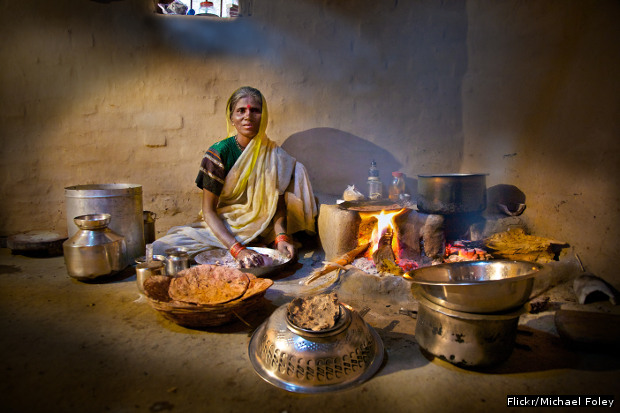67% Of Rural Households Still Use Firewood
More than 67% of rural households in India still depend on firewood or wood chips for cooking.
This is a decline of only 12% over two decades, according to the latest data released by the ministry of statistics.
The use of liquefied petroleum gas (LPG) for cooking in rural areas has increased from 2% to 15% of households during the period 1993-94 to 2011-12, an increase of 7.5 times.
Nearly 10% of rural households still cook with dung cakes, a marginal fall from 11.5% in 1993-94.
Source: Ministry of Statistics; Figures in %; #Other sources include gobar gas, charcoal and electricity.
About one million deaths are reported annually in India due to household air pollution caused by fumes from cooking, heating and lighting activities, IndiaSpend had earlier reported.
In contrast, more than 68% of urban households use LPG for cooking.
Many urban households too cook with firewood
Of environmental and economic relevance is the fact that 14% of households in urban areas still cook with firewood.
Source: Ministry of Statistics; Figures in %; #Other sources include gobar gas, charcoal and electricity.
The encouraging aspect in urban households is that the use of kerosene has declined from more than 23% to 6%.
In both rural and urban households, there are some who do not cook: 1% of rural households have no arrangements; the same holds good for nearly 7% of urban households.
Poorer states use firewood, richer states LPG
Data from the states highlight the imbalances between rural and urban households.
More than 93% of rural households in Chhattisgarh use firewood or wood chips to cook with followed by Rajasthan (89%) and Odisha (87%).
Source: Ministry of Statistics; Figures in %
In urban India, Haryana reported more than 86% of households using LPG for cooking purpose, followed by Andhra Pradesh (77%) and Punjab (75%).
Source: Ministry of Statistics; Figures in %
Lighting follows urban-rural differences
The rural-urban difference continues in lighting sources. While more than 96% of urban households use electricity for lighting, only 73% of rural households use electricity as an energy source for lighting.
More than 26% of rural households still use kerosene as the primary energy source for lighting.
Source: Ministry of Statistics; Figures in %
Source: Ministry of Statistics; Figures in %
No Indian state has reported using only electricity for lighting in urban or rural areas, despite the focus on 24x7 power for all households across the nation by various governments.
Source: Ministry of Statistics; Figures in %
Bihar was at the bottom of the list, with 26% of rural households electrified, followed by Uttar Pradesh at 40% and Assam 55%.
Maharashtra and Tamil Nadu reported the highest electricity use in urban areas at 99%, followed by Karnataka (98%) and Andhra Pradesh (98%). Occupying the bottom of the urban-areas-with-electricity list were Bihar (81%), Uttar Pradesh (88%) and Assam (90%).
Source: Ministry of Statistics; Figures in %
Electricity use has spread, but India lags compatriots in BRICS
Over the last two decades, electricity has clearly replaced kerosene as the primary source of lighting in both rural and urban areas. While 62% of households used kerosene in rural India in 1993-94, the figure has dropped to 26%.
The use of electricity as a source of lighting has improved from 83% in urban households in 1993-94 to 96% in 2011-12.
Overall, electricity consumption in India is the lowest amongst the BRICS (Brazil, Russia, India, China, South Africa), according to this Brazilian government study.
An average Indian's electricity consumption is 75% less than a Russian's and 80% less than a South African. An average Chinese consumes seven times more electricity than an Indian while a Brazilian consumes 2.6 times more.
Source: Brics Statistical Publication 2014, *BP Statistical Review 2015
___________________________________________________________________
“Liked this story? Indiaspend.com is a non-profit, and we depend on readers like you to drive our public-interest journalism efforts. Donate Rs 500; Rs 1,000, Rs 2,000.”



